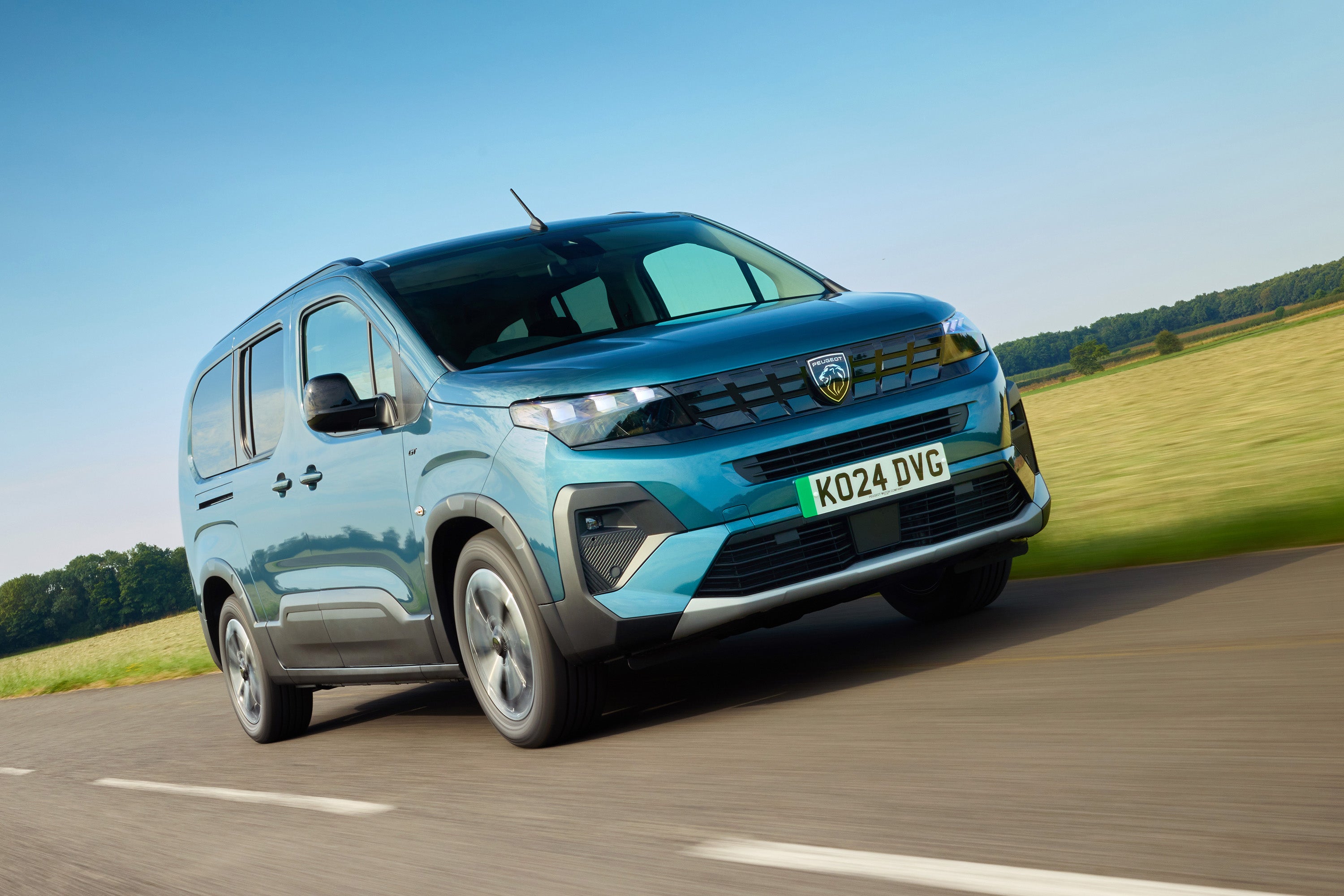Peugeot e-Rifter Review 2025: Price, specs & boot space
Written by Ivan Aistrop
Quick overview
Pros
- Enormously roomy and practical
- Comfortable and easy to drive
- Potentially low running costs
Cons
- Not exactly glamorous
- Limited real-world range
- Not a great Euro NCAP rating
Overall verdict on the Peugeot e-Rifter
"The appeal of the Peugeot e-Rifter is very simple: as a compact van-based people-carrier, it’s designed to provide as much space and practicality as it possibly can in a relatively small footprint. Happily, it does that exceptionally well. Find out why in our Peugeot e-Rifter review."
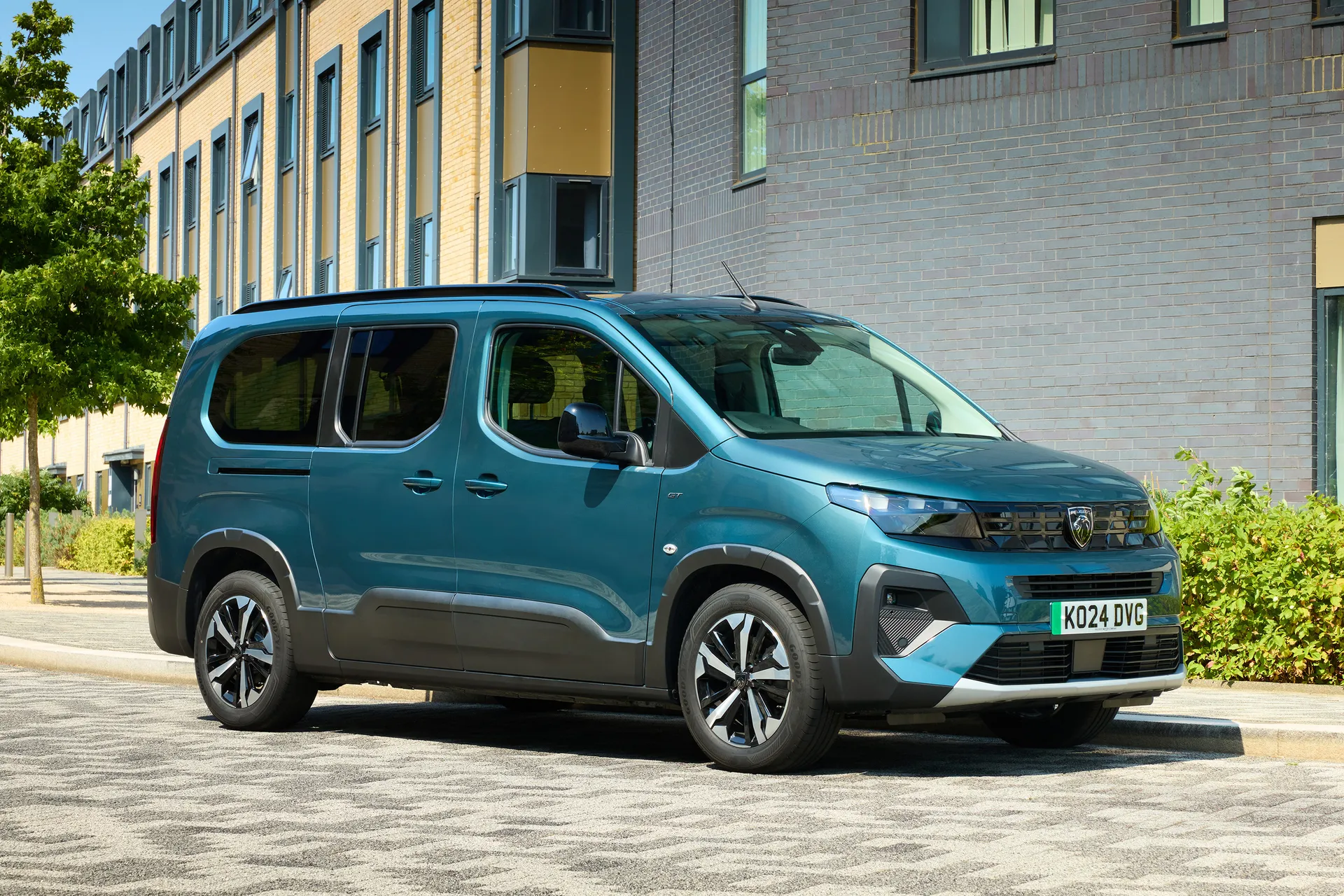
While the draw of the model is simple, however, the history of it is anything but, and not just because it’s a badge-engineered van-based passenger car that shares its mechanicals with the Peugeot Partner panel van, as well as other vans from brands within the same Stellantis manufacturing group including the Citroen Berlingo, and Vauxhall Combo. And not just because it’s also all-but identical to the van-based people carriers that are also offered by those two brands.
No, the landscape is made even more complicated because the Rifter has undergone vast amounts of significant change since it was first introduced back in 2018. Back then, it was sold exclusively with petrol and diesel engines as simply the Peugeot Rifter, and the all-electric e-Rifter we're covering here didn’t arrive until 2021. And once it did, it wasn’t long before Peugeot withdrew the combustion-engined versions of the Rifter from sale, leaving only the e-Rifter.
We’ll be honest, the range isn’t great compared to many electric cars. The small 52kWh battery initially gave a WLTP range of up to 172 miles, while improvements made during a facelift in 2024 upped that figure to 199 miles. And although that number is already pretty modest compared to some electric cars, our experience with the car would suggest that real-world returns won’t be anywhere near as generous as that: do a long motorway schlep on a cold day, and you might struggle to get much over half that.
Otherwise, though, there’s plenty to recommend the e-Rifter. Performance is modest but sufficient, it’s a comfortable and easy car to drive, and refinement is pretty good. It’s solidly made and decently equipped, and prices shouldn’t break the bank.
Its primary appeal, though, is its colossal practicality. It isn’t a huge car, but the space inside it is simply massive, both for people and for luggage. And that’s regardless of whether you choose the five-seat Standard version or the slightly longer seven-seat Long version. There’s also a vast array of storage areas on board, keeping clutter at bay.
Okay, so it’s not the most glamorous-looking car in the world, and it probably won’t have your neighbours glaring at your driveway with envy. However, if you’re after ultimate practicality in a relatively compact car, then we can’t think of many better vehicles.
Is the Peugeot e-Rifter right for you?
If you want a relatively compact vehicle that has as much practicality as it’s possible to muster, then the Rifter is absolutely right for you: it’s about as practical and as versatile as cars of this size get. You’ll have to be primarily a short-range user, though, because these days, the Rifter is only available in all-electric e-Rifter form. Range has improved since the 2024 facelift, but it’s still limited according to the official figures, and even more limited in the real world.
What's the best Peugeot e-Rifter model/battery to choose?
The basic Allure model doesn’t miss out on too much in the way of luxury equipment, so we reckon most buyers will be okay sticking with that. We can’t see the GT’s slightly smarter looks as being a reason to make the upgrade because the Rifter isn’t exactly a style statement to begin with. However, so might feel compelled to make the jump up to GT trim for the convenience of adaptive cruise control and a 180-degree reversing camera.
What other cars are similar to the Peugeot e-Rifter?
There are a couple of cars that are extremely similar to the e-Rifter: almost identical, in fact. The Vauxhall Combo Life Electric is one, and the Citroen e-Berlingo is another, although the latter is unique in this badge-engineered group due to the fact it’s still offered with petrol and diesel engines. Toyota also sells an electric variant of the same vehicle, known as the Proace City Verso, despite not being part of Stellantis.
There are other rivals in the compact van-based MPV class, too. Ford offers two in the form of the Tourneo Courier and Tourneo Connect, while there’s also the Volkswagen Caddy.
Comfort and design: Peugeot e-Rifter interior
"Like most Peugeot models, the e-Rifter’s cabin has the French firm’s trademark ‘i-Cockpit’ interior design approach. This might sound fairly incidental, but it can have a big effect on how comfortable and usable the Rifter is from the driver’s seat."
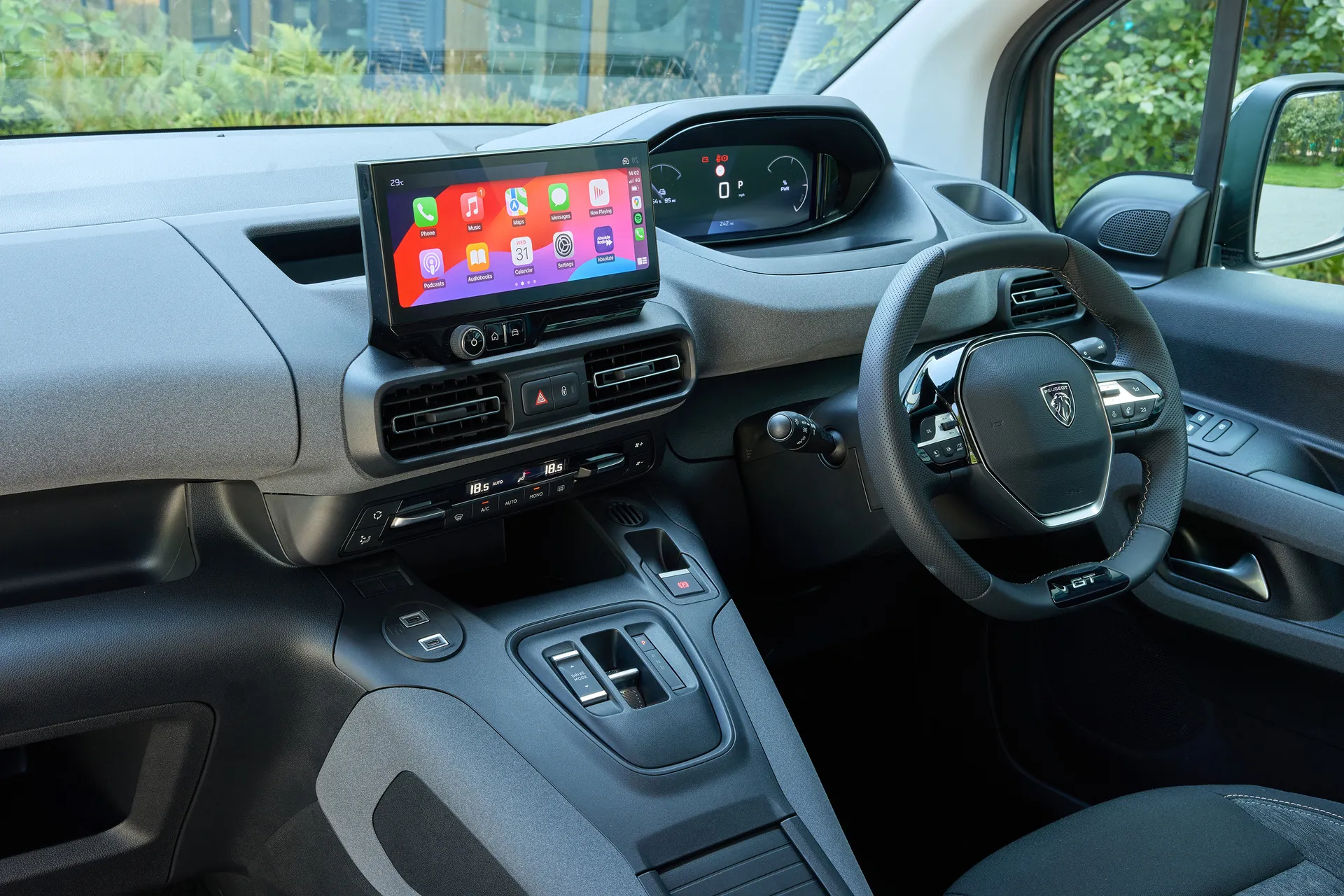
With most cars, you look at your driving instruments through your steering wheel. With i-Cockpit, meanwhile, you have a smaller-than-average steering wheel, and you view your high-set instrument panel over the top of it instead.
Peugeot’s marketeers will tell you that this places your essential driving information closer to your view of the road, meaning you don’t have to divert your eyes as far to see it. And they may even be right. What it also means, though, is that you have to set your steering wheel considerably lower than you normally would in order to see your instruments.
For some drivers, this won’t be a problem at all. For others, it’ll feel slightly awkward. For others, it’ll be uncomfortable. And for others, they might struggle to fit behind the wheel at all, especially if they’re particularly long-of-leg. Our advice? Don’t buy an e-Rifter without spending some time in the driver’s seat to figure out which camp you fall in.
We like the fact that there are physical air-con controls so that you can adjust your cabin temperature without having to muck about with the touchscreen. However, the temperature toggles aren’t backlit, so they’re impossible to see when you’re driving in the dark.
Quality and finish
You can see signs of the e-Rifter’s commercial vehicle roots in the way the cabin is put together. The assembly is very sturdy and pretty much all the plastics you see are hard and durable, rather than soft-touch and tactile like you’ll find in many passenger cars.
However, the e-Rifter does feel posher than the Peugeot Partner van on which it's based. That’s mainly because certain parts of the interior (namely the top of the dashboard, parts of the doors and parts of the centre console) are covered in a fabric finish which - when combined with the few smatterings of metallic and gloss-black trim dotted around - is really effective in making things look more interesting than they otherwise would.
Infotainment: Touchscreen, USB, nav and stereo in the Peugeot e-Rifter
When the e-Rifter was first released, it came with an 8.0-inch central touchscreen. Allure cars had physical dials behind the steering wheel, while on GT cars, these were upgraded to a 10.0-inch digital cluster. During the 2024 facelift, the digital instrument panel was made standard across the range, and the central screen in both versions was upgraded to a 10.0-inch item.
Either way, the system supports DAB radio, Bluetooth, intelligent voice control, Apple CarPlay and Android Auto, and you also get steering wheel audio controls.
The on-screen interface is reasonably simple, so once you’ve spent a few minutes familiarising yourself with the system, it’s fairly easy to find your way around and find and operate the functions you want. It’s not perfect, though: Some of the animations and screen transitions take an irritatingly long time, and the screen sensitivity isn’t great, so registering an instruction will often take a couple of attempts.
Space and practicality: Peugeot e-Rifter boot space
The e-Rifter comes in two distinct forms. The regular version, known as the Standard, measures 4,405mm in length and comes with five seats. As the name suggests, the Long is a little lengthier at 4,755mm - some of the extra length lies in the wheelbase (the space between the front- and rear wheels) and some of it in the rear overhang - and comes with up to seven seats. We say ‘up to’, because once upon a time, all Long Rifters got the extra pair of tiltable and removable seats, but these days, you only get these third-row seats with Allure trim: specify a Long in GT trim, and you only get an even-more-massive boot. More on that in a moment.
Whichever version you choose, and whichever seat you end up in, you’ll have lots of space, even if you’re a tall adult sitting in the rearmost row. All the seats have an upright seating position, and that allows every single chair a generous amount of legroom, while the high roof allows everyone generous headroom.
In the Allure, your three middle-row seats are arranged in a 60/40 split-folding bench, while in the GT, you get three individual seats in the second row. Either way, all three have Isofix child seat mounting points, and there’s plenty of shoulder room, allowing everyone to travel comfortably when fully loaded up. Getting in and out of tight parking spaces is also made much easier by the standard sliding rear doors on both sides of the car.
It’ll come as little surprise that a car derived from a van is even more impressive when it comes to cargo-carrying capability. In the five-seat Standard version, the boot measures a whopping 775 litres beneath the load cover (or 1,355 litres when loaded up to the ceiling), or up to 3,000 litres when travelling in two-seat mode.
In the Long version, there’s 209 litres behind the third-row seats, but when you don’t need those and they can be removed (you’ll need somewhere to store them, though), then there’s 1,050 litres beneath the load cover in five-seat mode (or 1,900 litres when loaded up to the ceiling), or up to 3,500 litres when travelling in two-seat mode.
Peugeot claims that whichever seating arrangement your e-Rifter has, folding the second-row seating down leaves a completely flat floor. It doesn’t. Drop the seats in question, and there’s a small step in the extended load area, and a small slope as well.
If you need to carry particularly long items, then the e-Rifter comes with a front passenger seat that folds down. Doing so in the Standard version allows you to take items of up to 2,700mm in length, while the Long version will accommodate items of up to 3,050mm.
We know that’s a lot of numbers. If they don’t mean a lot to you, just know that the e-Rifter delivers a simply astonishing amount of space and versatility for a car with such a compact footprint. It’s undoubtedly the best thing about the car.
Handling and ride quality: What is the Peugeot e-Rifter like to drive?
"Take one look at the boxy shape of the e-Rifter, and you’ll have no expectation that it’ll deliver a scalpel-sharp driving experience. And it doesn’t, but importantly, it is comfortable, which is much more of a priority in a people carrier."
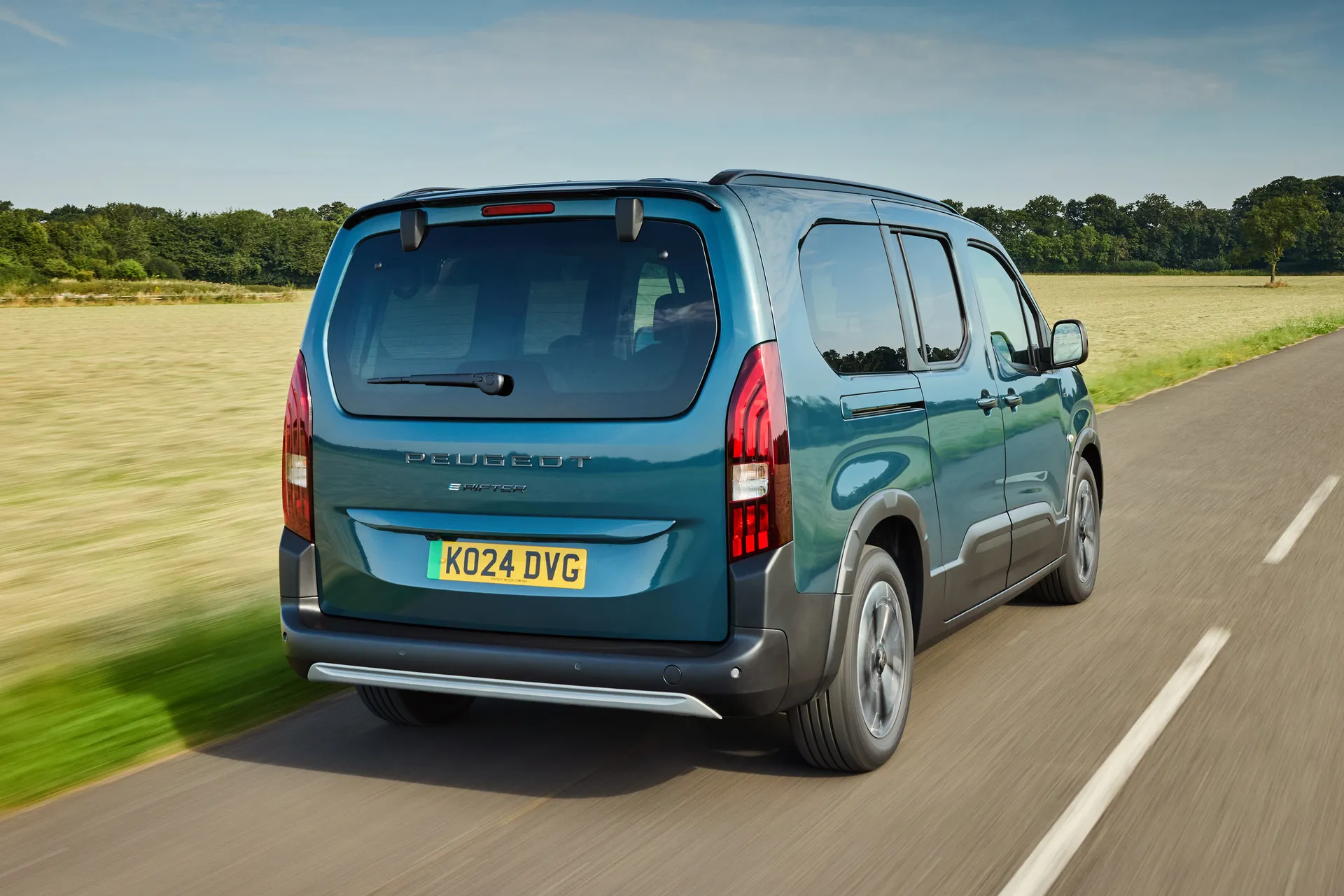
Despite being mechanically identical to the Peugeot Partner Panel van, you’ll actually find that the e-Rifter’s ride feels quite a bit more settled. The soft suspension is really good at smothering potholes and sunken drain covers, while there’s less jumpiness over broken surfaces at all speeds. We suspect that’s due to the added weight of the extra seats, windows and carpets sitting on the springs, but whatever the case, things feel appreciably smoother and more relaxed.
And while the handling isn’t the nimblest, it’s really not bad given the e-Rifter’s commercial vehicle roots. In corners, there’s more grip and less body roll than you might be expecting, so it certainly doesn’t feel untidy when changing direction. The steering is very light and very slow, which you won’t welcome on a country road, but when you’re manoeuvring in the city and it’s making your life so much easier, you’ll understand perfectly why it’s been set up like that.
What motors and batteries are available in the Peugeot e-Rifter?
The Peugeot e-Rifter is powered by a front-mounted electric motor, fed by a 52kWh battery (50kWh usable). The amount of power and performance you get depends on which of the various driving modes you select.
When you start the car, it defaults to Normal mode, which gives you an output of 109PS. Select Eco mode, meanwhile, and your output is limited to 82PS (and your heating and air-con functionality is also limited) in order to eke out a few extra miles of range. If you want to sacrifice some of your range for extra performance, though, then selecting Power mode gives you the motor’s full force of 136PS. In this mode, with the car performing to its optimum level, you can get from 0-62mph in 11.3 seconds, and onto a top speed of 81mph.
The e-Rifter is never particularly quick, then, but neither is it too pedestrian. Even in Eco mode, there’s enough urge to stick with the traffic around you at modest speeds, although if your velocity rises to much more than 50mph or so, then you might want to switch to Normal mode to give you enough responsiveness to react to the ebb and flow of faster-moving traffic. You won’t often feel the need to select Power mode because the e-Rifter ultimately doesn’t feel much quicker with it applied, although it might come in handy when overtaking or joining a motorway on a short sliproad.
Like most electric cars, the e-Rifter’s motor sends its power to the wheels through a single-speed transmission, which you operate much like a traditional automatic transmission: you select drive and off you go, although no actual gear changes take place. That means your acceleration - however, modest - arrives in one single unbroken stream.
Peugeot e-Rifter range: How far can you travel on a charge?
The Peugeot e-Rifter has a battery pack with a total capacity of 52kWh, which equates to 50kWh of usable capacity. Initially, this gave the vehicle an official WLTP driving range of 172 miles, but in the post-facelift version from 2024 onwards, improvements to the efficiency of the powertrain increased the official range to 199 miles. In both cases, those figures are marginally worse than those for the corresponding version of the mechanically identical Peugeot Partner panel van, we suspect due to the added weight of the extra windows, seats and carpets on board.
Either way, though, don’t expect to get anywhere near those figures in the real world, especially if the weather is cold and you’re doing lots of high-speed motorway miles, both of which are things that electric cars don’t particularly like. Based on our experience with the car, you’ll struggle to get much over 100 miles before recharging on a chilly motorway schlep.
Refinement and noise levels
Electric cars are often considerably quieter than their combustion-engined counterparts, and that’s the case here. The electric motor barely makes a sound, which makes a striking contrast if you’re used to the mechanical clatter of a petrol or diesel engine.
That low level of propulsion noise does make wind- and road noise more noticeable at higher speeds, but these are still pretty well contained for peaceful progress. You might hear the suspension clonking a bit over particularly nasty bumps, but it’s nothing that’ll upset the calm. This is a relaxed way to get around.
Safety equipment: How safe is the Peugeot e-Rifter?
All versions of the e-Rifter come with a suite of driver assistance systems that includes an advanced autonomous emergency braking system, high-beam assist headlights, lane keep assist, intelligent speed limit assist, and driver attention alert. Go for the GT trim, and you also get adaptive cruise control with stop-and-go traffic function and a lane positioning system.
The Rifter was crash-tested by Euro NCAP in 2018, before it was available as the all-electric e-Rifter, but the body says that the same result applies to the electric version. Unfortunately, it only scored four out of five stars, at a time when the majority of models were scoring the full five.
Peugeot e-Rifter charging times: How much does it cost to charge?
"Charge your e-Rifter on a 7.4kWh wall box home charger, as most drivers will, and your battery will be fully replenished from empty in six hours and 43 minutes."
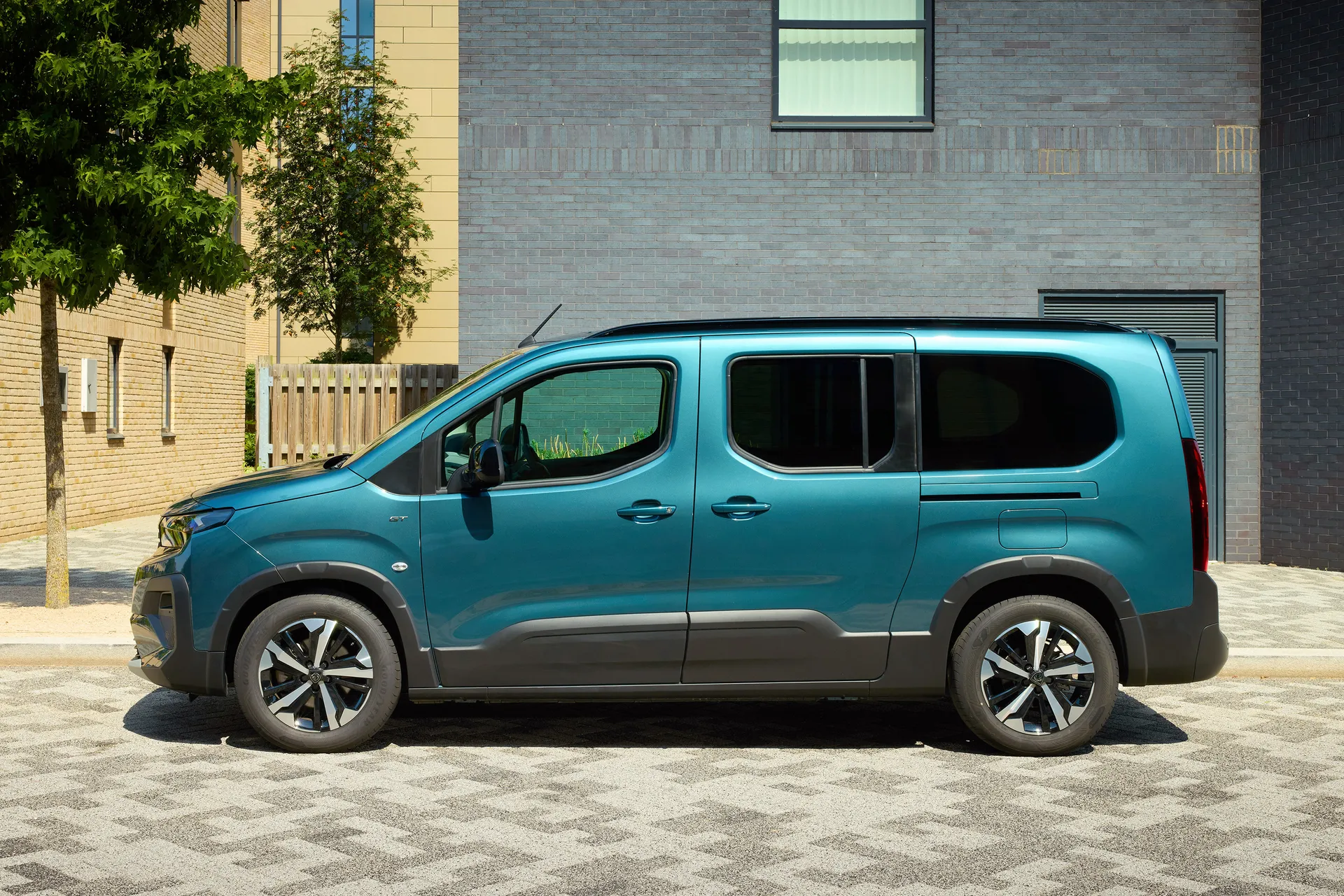
If you can’t - or won’t - get a wall box charger installed, and you attempt to juice up your e-Rifter using a regular three-pin domestic socket, then you’ll be waiting a while longer. Empty to full will take 22 hours and 30 minutes. Jeepers. You’ll also have to pay Peugeot a few quid extra for the cable that’ll allow you to do it.
Assuming your domestic electricity is charged at the UK’s national average, then a charge at home will cost you around £14. Get yourself on a domestic power tariff that allows you to charge your car overnight on heavily discounted off-peak power, and you’ll pay even less: we’re talking probably less than half.
For those times when you need to charge as quickly as possible, the e-Rifter supports DC rapid charging at up to 100kW, meaning that if you can find an appropriately pokey public rapid charger, a 0% to 80% top-up can be delivered in 38 minutes. Bear in mind, though, that the power that comes out of these chargers is a lot more expensive than domestic power. You can probably take the figure we quoted earlier and treble it in most cases.
Peugeot e-Rifter reliability and warranty
The HonestJohn.co.uk Satisfaction Index, our go-to source of reliability data, doesn’t paint a good picture of Peugeot’s reliability. The latest iteration of the study ranks the French firm as the second-least reliable manufacturer in the entire study, out of 29 carmakers considered. By any measure, that’s poor. It’s unclear how much - if anything - the Rifter or e-Rifter had to do with that result, though.
Peugeot’s warranty is nothing to write home about, either. You get two years of unlimited-mileage manufacturer cover, followed by a third year of retailer-supplied cover limited to 60,000 miles. That’s even more irritating when you consider that the mechanically identical Peugeot Expert van gets 100,000 miles of third-year cover, and that’s before you compare the e-Rifter’s warranty to those of more generous arrangements from Hyundai, Kia and Toyota.
Your traction battery gets its own warranty of eight years or 100,000 miles, whichever occurs first. If your battery pack falls below 70% of its original capacity during that period, it’ll be repaired or replaced for free.
Service intervals on the e-Rifter stand at every 25,000 miles or two years, so maintenance work isn’t needed too regularly.
Peugeot e-Rifter insurance groups and costs
The most basic version of the e-Rifter (the Standard body style model in Allure trim) sits in insurance group 19, while all other versions sit in group 20. Since insurance groups run from 1 (the cheapest) to 50 (the most expensive), it tells you that premiums on the e-Rifter should be on the more palatable side of average.
VED car tax: What is the annual road tax on a Peugeot e-Rifter?
As an electric car, the e-Rifter is currently exempt from car tax. That’ll only be the case until April 2025, though, because that’s when the Vehicle Excise Duty VED exemption for EVs is due to expire, and electric car owners will likely face the same road tax costs as everyone else. It currently stands at £190 per year for petrol and diesel cars, and £180 for most hybrids, but we can also see that going up come April, too.
Peugeot e-Rifter price
“If you were to specify an e-Rifter brand new, then you’d see that prices for the Allure start at just over £32,000 on-the-road in Standard form, rising to just over £33,000 for the Long. Go for the GT, and you’ll be paying around £35,000 for the Standard, and around £36,000 for the Long, but remember that on the GT trim, you’re only getting the extra boot space, not the extra seats.”
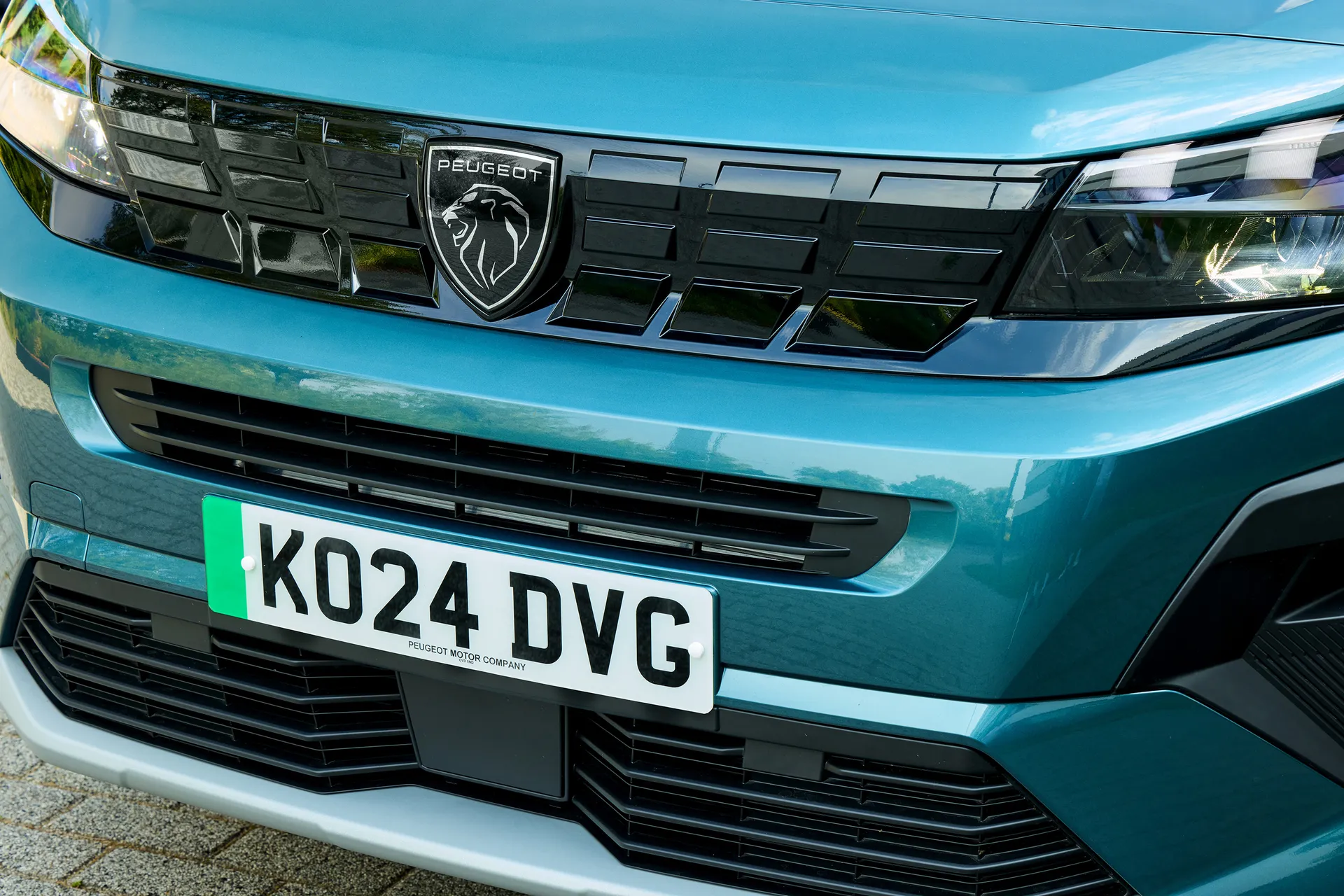
The used car market isn’t exactly awash with examples of the all-electric e-Rifter because it’s a fairly niche offering, but if you can find one, there are some excellent savings to be made. Look through the heycar classifieds, and you’ll find that £23,000 is enough to get you an as-new entry-level example of around a year old with a super-low three-figure mileage. That’s definitely a saving worth making.
Trim levels and standard equipment
We’ve already talked elsewhere about the infotainment and safety kit that the e-Rifter comes with, so we won’t go over all that again. In terms of other kit, Allure versions come with manual air-conditioning, a heated leather steering wheel, an electronic parking brake, automatic lights and wipers, electric front windows, cruise control, rear parking sensors, front foglights, LED headlights, and 16-inch steel wheels.
GT cars look a little slicker with 17-inch alloy wheels, exterior styling enhancements, and rear privacy glass, while you also get automatic climate control air-con, adaptive cruise control, electric rear windows, carpet mats, and a 180-degree reversing camera.
Ask the heycar experts: common questions
Is the Peugeot e-Rifter any good?
Is the Peugeot e-Rifter electric?
Is the Peugeot e-Rifter an automatic?
Get our latest advice, news and offers
Keep me updated by email with the latest advice, news and offers from heycar.
By submitting you agree to our privacy policy
